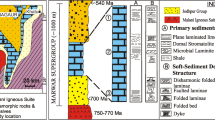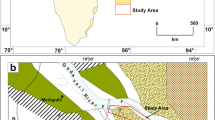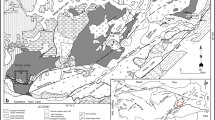Abstract
The Permo-carboniferous glacio-marine Talchir Formation of Dudhi Nala, West Bokaro Coal Basin, India, hosts soft-sediment deformation structures that originated from liquefaction and concomitant fluidization of unconsolidated sediments at or close to the sediment–water interface. Since liquefaction of water saturated sediments may be initiated by different endogenic or exogenic triggering agents, identification of the trigger needs careful analysis of the deformation structure, as well as depositional mechanism and environment of deposition of the host sediments. In-depth analysis of the studied liquefaction- and fluidization-induced soft-sediment deformation structures and sedimentary attributes of the host sediments of the studied succession unequivocally stand against the role of strong wave and tidal action, rapid sediment loading, mass-flow and subaqueous slides related shear stress, and water or gas seepage as the triggering agent. However, development of the soft-sediment deformation structures, close to sediment–water interface, closeness to syn-sedimentary fault, flowage along the tilt towards the fault, confinement within undeformed beds, episodic character and close similarities with structures that are formed during recent earthquakes, are consistent with seismic triggering for liquefaction. The studied shallow marine sediments record a sequel of climatic amelioration, glacial retreat, shallow marine sedimentation, glacio-isostatic rebound and related syn-sedimentary faulting and development of soft-sediment deformation structures.




Similar content being viewed by others
References
Allen C R 1975 Geological criteria for evaluating seismicity; AAPG Bull. 86 1041–1057.
Allen J R L 1977 The possible mechanics of convolute lamination in graded sand beds; J. Geol. Soc. London 134 19–31.
Allen J R L 1984 Sedimentary structures, their character and physical basis; Elsevier, Amsterdam 2 663p.
Allen J R L 1986 Earthquake magnitude-frequency, epicentral distance, and soft-sediment deformation in sedimentary basins; Sedim. Geol. 46 67–75.
Alfaro P, Delgado J, Estevez A, Molina J M, Moretti M and Soria J M 2002 Liquefaction and fluidization structures in Messinian storm deposits (Bajo Segur Basin, Betic Cordillera, southern Spain); Int. J. Earth Sci. (Geologische Rundschau) 91 505–513.
Alvarez W, Staley E, O’Connor D and Chan M 1998 Syn-sedimentary deformation in the Jurassic of south eastern Utah – A case of impact shaking?; Geology 26 579–582.
Bhattacharya H N, Mukhopadhyay G and Bose P K 1989 Hummocky cross-stratification and its hydraulic and climatic implications in Talchir Formation, Dudhi Nala, Hazaribagh, Bihar; J. Geol. Soc. India 34 398–404.
Bhattacharya H N and Bandyopadhyay S 1998 Seismites in a Proterozoic tidal sequence, Singhbhum, Bihar, India; Sedim. Geol. 119 239–252.
Bhattacharya H N, Chakraborty A and Bhattacharya B 2005 Significance of transition between Talchir Formation and Karharbari Formation in lower Gondwana Basin evolution – A study in west Bokaro Coal Basin, Jharkhand, India; J. Earth Syst. Sci. 114 275–286.
Bose P K, Mukhopadhyay G and Bhattacharya H N 1992 Glaciogenic coarse clastics in a Permo-Carboniferous bedrock trough in India: A sedimentary model; Sedim. Geol. 76 79–97.
Campbell K A, Nesbitt E A and Bourgeois J 2006 Signatures of storms, oceanic floods and forearc tectonism in marine shelf strata of the Quinault Formation (Pliocene), Washington, USA; Sedimentology 53 945–969.
Chakraborty A 1977 Upward flow and convolute lamination; Senckenbergiana Marit. 9 285–305.
Chen J, Chough S K, Chun S S and Han Z 2009 Limestone pseudoconglomerates in the Late Cambrian Gushan and Chaomidian Formations (Shandong Province, China): Soft sediment deformation induced by storm-wave loading; Sedimentology 56 1174–1195.
Chiarella D, Moretti M, Longhitano S G and Muto F 2016 Deformed cross stratified deposits in the Early Pleistocene tidally-dominated Catanzaro strait fill succession, Calabrian Arc (southern Italy): Triggering mechanisms and environmental significance; Sedim. Geol. 344 277–289.
Davies S J and Gibling M R 2003 Architecture of coastal and alluvial deposits in an extensional basin: The Carboniferous Joggins Formation of eastern Canada; Sedimentology 50 415–439.
Ghosh S K 1993 Structural Geology: Fundamentals and Modern Developments; Pergamon, Oxford.
Greb S F and Archer A W 2007 Soft-sediment deformation produced by tides in a meizoseismic area, Turnagain Arm, Alaska; Geology 35 435–438.
Hilbert-Wolf H L, Roberts E M and Simpson E L 2016 New sedimentary structures in seismites from SW Tanzania: Evaluating gas- vs. water-escape mechanisms of soft deformation; Sedim. Geol. 344 253–262.
Jiang J, Zhong N, Li Y, Xu H, Yang H and Peng X 2016 Soft-sediment deformation structures in the Lixian lacustrine sediments, Eastern Tibetan Plateau and implications for postglacial seismic activity; Sedim. Geol. 344 123–134.
Lowe D R 1975 Water escape structures in coarse grained sediments; Sedimentology 22 157–204.
Lunina O V and Gladkov A S 2016 Soft-sediment deformation structures induced by strong earthquakes in southern Siberia and their paleoseismic significance; Sedim. Geol. 344 5–19.
Massari F, Guibaudo G, D’Alessandro T and Davaud E J 2001 Water-upwelling pipes and soft-sediment deformation structures in lower Pleistocene calcarenites (Salento, southern Italy); GSA Bull. 113 545–560.
Mastalerz K and Wojewoda J 1993 Alluvial-fan sedimentation along an active strike–slip fault: Plio-Pleistocene Pre-Kaczawa fan, SW Poland; Int. Assoc. Sedim. Spec. Publ. 17 293–304.
Moretti M, Alfaro P, Caselles O and Canas J A 1999 Modelling seismites with a digital shaking table; Tectonophys. 304 369–383.
Moretti M and Sabato L 2007 Recognition of trigger mechanisms for soft-sediment deformation in the Pleistocene lacustrine deposits of the Sant’Arcangelo Basin (southern Italy): Seismic shock vs. overloading; Sedim. Geol. 196 31–45.
Mukhopadhyay G and Bhattacharya H N 1994 Facies analysis of Talchir sediments (Permo-carboniferous), Dudhi Nala, Bihar, India – Glaciomarine Model, 9th International Gondwana Symposium, Hyderabad, India, vol. 2, Oxford and IBH Publishing Co., New Delhi, pp. 737–753.
Mukhopadhyay G, Mukhopadhyay S K, Roychowdhury M and Pauri P K 2010 Stratigraphic correlation between different Gondwana basins of India; J. Geol. Soc. India 76 251–256.
Nagtegaal P J C 1963 Convolute lamination, metadepositional ruptures and slumping in an exposure near Pobla de Segur (Spain); Geologie en Mijnbouw 42 363–374.
Onorato M R, Perucca L, Coronato A, Rabassa J and Lopez R 2016 Seismically-induced soft-sediment deformation structures associated with the Magallanes-Fagnano Fault System (Isa Grande de Tierra del Fuego, Argentina); Sedim. Geol. 344 135–144.
Owen G 1996 Experimental soft-sediment deformation: Structures formed by the liquefaction of unconsolidated sands and some ancient examples; Sedimentology 43 279–293.
Owen G and Moretti M 2008 Determining the origin of soft-sediment deformation structures: A case study from Upper Carboniferous delta deposits in south-west Wales; Terra Nova 20 237–245.
Owen G and Moretti M 2011 Identifying triggers for liquefaction-induced soft-sediment deformation in sands; Sedim. Geol. 235 141–147.
Postma G 1983 Water escape structures in the context of a depositional model of a mass flow dominated conglomeratic fan-delta (Abrioja Formation, Pliocene, Almeria Basin, Spain); Sedimentology 30 91–103.
Sarkar S, Choudhuri A, Banerjee S, van Loon A J and Bose P K 2014 Seismic and non-seismic soft-sediment deformation structures in the Proterozoic Bhander Limestone, central India; Geologos 20(2) 89–103.
Seilacher A 1969 Fault-graded beds interpreted as seismites; Sedimentology 13 155–159.
Seth A, Sarkar S and Bose P K 1990 Syn-sedimentary seismic activity in an immature passive margin basin (Lower Member of the Katrol Formation, Upper Jurassic, Kutch, India); Sedim. Geol. 68 279–291.
Sengupta S, Chakraborty A and Bhattacharya H N 1999 Fossil Polyplacophora (Mollusca) from Upper Talchir sediments of Dudhi Nala, Hazaribagh, Bihar; J. Geol. Soc. India 54 523–527.
Shanmugam G 2016 The seismite problem; J. Palaeogeogr. 5(4) 318–362.
Shanmugam G 2017 Global case studies of soft-sediment deformation structures (SSDS): Definitions, classifications, advances, origins, and problems; J. Palaeogeogr. 6(4) 251–320.
Sims J D 1973 Earthquake-induced structures in sediments in Van Norman Lake, San Fernando, California; Science 182 161–163.
Sims J D 1975 Determining earthquake recurrence intervals from deformational structures in young lacustrine sediments; Tectonophys. 29 141–152.
Su D C and Sun A P 2012 Typical earthquake-induced soft-sediment deformation structures in the Mesoproterozoic Wumishan Formation, Yongding River Valley, Beijing, China and interpreted earthquake frequency; J. Palaeogeogr. 1 71–89.
Snyder M E and Waldron J W F 2016 Unusual soft-sediment deformation structures in the Maritimes Basin, Canada: Possible seismic origin; Sedim. Geol. 344 145–159.
Ten Haaf E 1956 The significance of convolute lamination; Geology Mijnbouw 18 188–194.
Toro B and Pratt B R 2016 Sedimentary record of seismic events in the Eocene Gran River Formation and its implications for regional tectonics on lake evolution (Bridger Basin, Wyoming); Sedim. Geol. 344 175–204.
Van Loon A J 2009 Soft-sediment deformation structures in siliciclastic sediments: An overview; Geologos 15 3–55.
Zhang C, Wu Z, Gao L, Wang W, Tian Y and Ma C 2007 Earthquake-induced soft-sediment deformation structures in the Mesoproterozoic Wumishan Formation, North China, and their geologic implications; Sci. China, Earth Sci. 50 350–358.
Zheng L, Jiang Z, Liu H, Kong X, Li H and Jiang X 2015 Core evidence of paleoseismic events in Paleogene deposits of the Shulu Sag in the Bohai Bay Basin, east China, and their petroleum geologic significance; Sedim. Geol. 328 33–54.
Acknowledgements
The authors are thankful to two anonymous reviewers, whose constructive comments helped to improve the manuscript. The authors are also thankful to Techno India University, West Bengal for their support.
Author information
Authors and Affiliations
Corresponding author
Additional information
Communicated by Santanu Banerjee
Rights and permissions
About this article
Cite this article
Bhattacharya, H.N., Mukherjee, A. Soft-sediment deformation structures in a Permo-carboniferous glacio-marine setting, Talchir Formation, Dudhi Nala, India. J Earth Syst Sci 129, 87 (2020). https://doi.org/10.1007/s12040-020-1357-5
Received:
Revised:
Accepted:
Published:
DOI: https://doi.org/10.1007/s12040-020-1357-5




